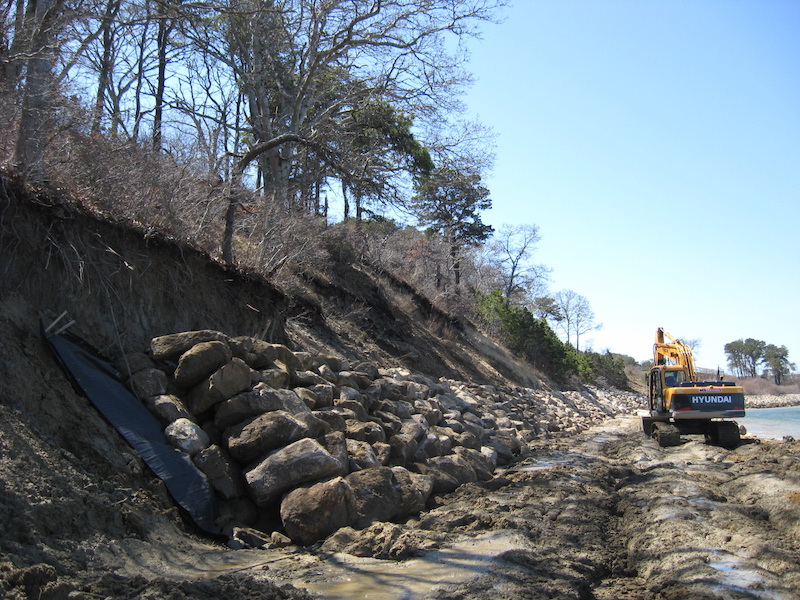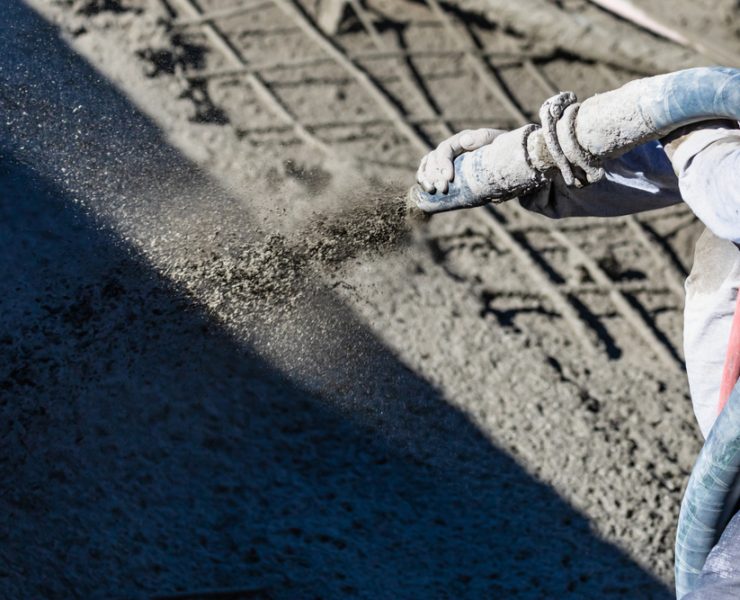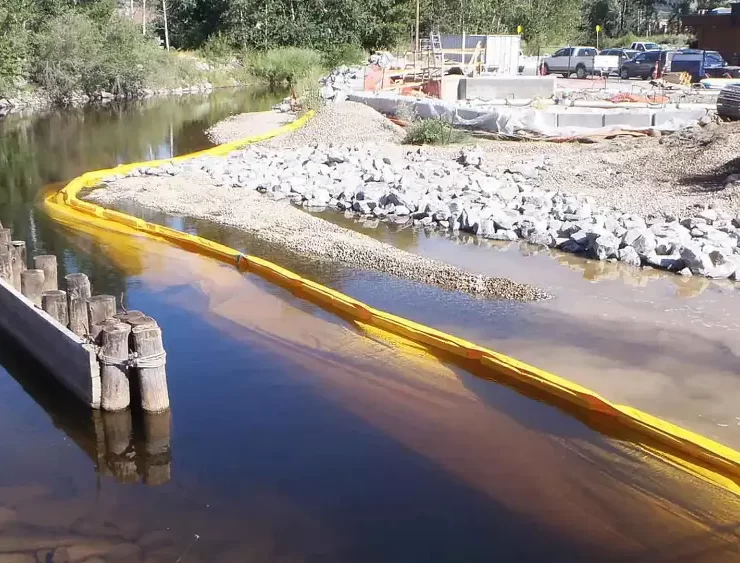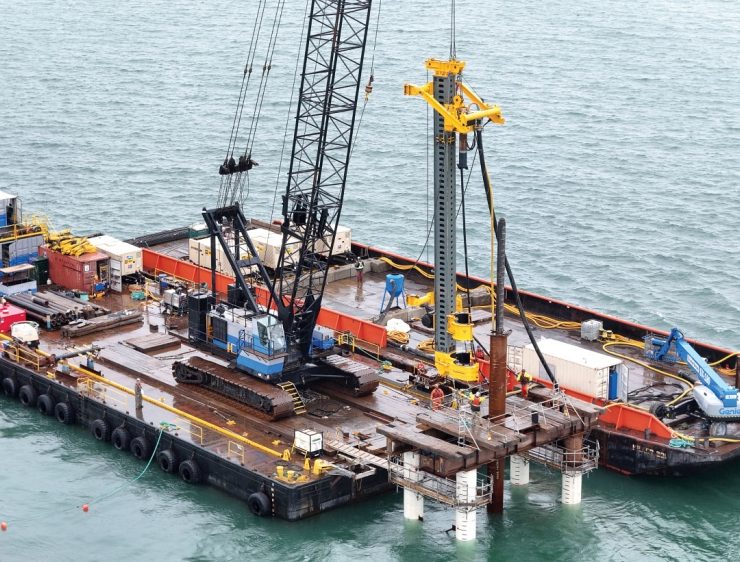Using Large Stone in Marine Construction Projects


View the complete article here.
Stone is a popular choice in construction, particularly for projects involving protection against water. Large stones are often used to protect embankments, levees, river banks and engineered features against erosion. They may also be used in the construction of dams, breakwaters, and other large structures.
There are five primary uses for large stones in construction projects:
- slope protection
- training structures
- retention dikes
- breakwaters and jetties
- zoned embankments
The advantages of using large stones in each of these types of construction is often dependent on large-scale production and processing of stone, as well as the placement on the structure.
Slope protection is an engineered feature constructed of large stone material in a relatively thin overlay on a slope that is otherwise vulnerable to erosion. Commonly referred to as riprap, this material adjusts to minor flank erosion or undercutting, while connoting to protect the slope.
Training structures are short, linear features constructed near the bank of a channel to control the pattern and velocity of river flow. Examples of training structures are vane dikes that run parallel to the bank and invoice spur dikes and groins that run perpendicular to the bank.
Rock training structures are typically low cost. They may be used also along coastlines to control sea drift currents and sand deposits. For example, coastal jetties constructed of large stones can train the flow of river outlets and may also function as groins and breakwaters.
Retention dikes impound saturated materials from dredging and other construction work.
Where waste is contaminated and control of leaches is of high priority, elaborate, zoned designs are sometimes used.
If wave attack is predicted, two or more zones of large stones are often incorporated. The outer zone is more critical.
Smaller stone material can usually be used, as they will maintain stability and support the layers. Larger stones can increase the cost of the project significantly and quality may be harder to control.
Breakwaters and jetties use multiple zones of different materials to protect against ocean wave attack, including very large, dense, and durable individual stones.
For some projects, manmade concrete units may be more cost-effective. Structures in deep water present special construction problems that can make placement, quality control and other factors more challenging.
Zoned embankments, such as rockfill dams, constitute one of the largest uses of large stone for construction projects. These projects usually have different material quality demands and can use weak rock.
However, immense quantities of stone are usually required. Excavations for spillways and outlet works, as well as quarries or stone borrow areas, can provide much of the stone material needed for zoned embankments.
Other uses for large stones in construction projects include placement:
- as energy dissipaters in plunge pools to reduce erosion of foundation soil or bedrock
- for structure protection placed around the upstream end of a bridge pier
- in masonry as landscaping stone to protect dikes or breakwaters

Materials and Construction Problems
Large stone materials are desirable for construction projects given their durability against weathering and other environmental influences. Even when buried under other zones, large stones used for construction projects are expected to remain strong and to resist degradation.
To achieve these goals, large stone materials must be chosen carefully to prevent settlement, slippage or alteration of subsurface drainage.
To be considered durable, stone material must resist several natural and man-made disturbances that are design-related, material-related and external. This includes factors such as wave dislodgment, rapid filling, storm surge, air corrosivity, freezing, heating, ice-block thrust, snow cover, root growth and vandalism.
One of the biggest influences on the use of large stones in construction is the economic factors associated with supply.
Because large stone is relatively rare and can be expensive to produce, it can be costly. Contractors should evaluate the cost of using large stone before embarking on a construction project using large stone.
An assessment should involve a consideration of production constraints as well as the cost and difficulty of transportation of large stone material.
Durability requirements are progressively harder to attain as the stone size requirement is increased. Problems with durability may include cracking, spalling (thin shells breaking away from the surface), delaminating or splitting, disaggregating (erosion or flaking away of the rock), dissolving or disintegrating.
During construction, design problems can often arise related to the stone materials. The stone size can become problematic, as undersized stones can translate to increased maintenance, premature repair or replacement or even failure of the engineered feature.
The density of the stone can also cause issue, particularly among sedimentary strata, that can vary in density from layer to layer across a quarry face.
If stones are tabular in shape, they are less stable hydraulically and more prone to splitting, while slab-shaped stones may be detrimental to rockfill applications.
The interaction of large stone features with other elements of a strict can cause problems. This may include mixing of bedding stone into riprap, for example.
Construction problems may also come up, particularly during complex projects. To avoid these issues, the contractor should clearly define the use of large stones on the job site.
This includes implementing guidelines for accepting stone and stone sources, installing quality control measures for placement of the stones, ensuring ongoing inspection for quality assurance, and ongoing surveillance and evaluation to detect and repair issues with large stones.
Investigation of Sources
When using large stones in a construction project, locating a source of this stone material is a top priority for contractors. Determining the availability, cost, suitability to design and quality of material is critical to the overall success of the project — and necessary before embarking on the design.
Because of the diverse array of climates and physical exposures in the United States, there is no one type of stone that is suitable for all construction projects.
However, there are some general guidelines that contractors can follow to select a durable stone material.
- It should be adequate to ensure the permanence of the structure or feature in the environment in which it is constructed.
- It should be sound, and free from cracks, seams and other defects that may increase deterioration from natural causes, or which may cause breakage during handling and placement.
- The chosen stone should also be resistant to weathering and disintegration from the local environment.
- Contractors should utilize laboratory tests as well as visual inspections and service records to make their selections, as cracks, veinlets, seams and overt deterioration are mostly revealed by visual inspection.
Evaluation of Sources at Project Site
For some projects that require large volumes of rock for structures such as embankments, rocks from required excavation or from an adjacent source quarry can be utilized.
Because these sources are untested for suitability and volume, they must be investigated in detail by the contractor and related personnel before being designated for use on the project.
The first step is to conduct geological mapping and characterization of the rock materials exposed in outcrops. This will help to develop an accurate picture of the geology of the project area, which can be integrated with requirements for rock strength and variability, joint spacings and orientations, weathering effects and landsliding.
Geological mapping coverage typically extends from the immediate project area outward to the surrounding area influenced by the project that may be situated properly for supplying stone or rock fill.
Next, subsurface investigations should be conducted to recover samples of the rock. The most effective means of doing so is through core drilling to obtain continuous samples of rock.
However, because core drilling is costly, its use should be limited.
Other options may include borehole photography and pressure testing. Calyx holes and pits may be drilled or excavated to investigate a potential rock source; the undisturbed sidewall can then be mapped, photographed and studied. In addition, a calyx core can be used for examination and testing.
If feasible, a test quarry can be established for projects where large quantities of rock will be needed. These quarries can range in size from large test pits to excavations of hundreds of thousands of yards.
Test quarries are useful when there may be a question about the suitability of rock, particularly in required excavations. They often provide information on cut slope design, appropriate blasting techniques, and methods of processing materials.
A test quarry should be located within the planned quarry, with the product used directly or stockpiled for later use.
Test fills can be used as a design technique to evaluate the suitability of stone for embankments. Test fills allow control for variables such as fill lift thickness, number of passes, compaction equipment type, and test-quarry parameters to enable a contractor to develop initial information on the rock fill as it will be used later in construction.
Next, contractors should estimate the quantity of rock material available at a new site. The presence of water or deterioration of quality should be noted, as either factor may reduce the estimated output. To allow for these factors, estimates should be conservative.
Finally, contractors should take environmental constraints into consideration. A potential stone source and a quarry development may detract from the natural beauty of an area, or otherwise cause environmental concerns during or after construction. As necessary, contractors should grade and landscape the quarry area to restore a natural appearance and control erosion.
Stone Testing
Stone testing is part of the investigation of materials for a construction project involving large stones. However, the testing of large stones for suitability for a particular construction project involves laboratory testing and other methods that require in-depth consideration to ensure that the proper stone is selected for each job site and project.
Physically testing and examining stone materials is crucial to the success of the construction project. As an initial matter, an understanding of the physical characteristics and behavior of the stone material is helpful in planning and design.
In addition, contracts often specify the physical properties of the stone material to be used.
There are numerous tests and methods that can be used to examine stone material. A decision about which methods and tests to use should be made based on considerations of the loading to be imposed, climatic conditions, and the severity of exposure of the stone in the project area.
Other factors to consider may include visual characteristics, unit weight, porosity, and durability against abrasion, wetting and drying, and freezing and thawing.
There are two primary methods of testing stones: laboratory and field testing. A third method, test blasting, may be used in certain circumstances.
Laboratory Testing
There are six basic laboratory tests that can be performed to check the quality and characteristics of stone material for construction. The specific test used will depend on the needs of the project.
Petrography identifies the composition and homogeneity of stone samples, as well as their general physical condition. Petrography is often essential for evaluating the suitability and durability of large stone.
However, it is limited to qualitative rather than quantitative appraisal. Samples selected for petrographic examination should include flaws that will be produced that are common to large stones.
Stone density tests are generally conducted on scraps that remain after slabs have been cut for other tests. These examinations reveal the intrinsic properties of stone related to its mass or density, including its unit weight, specific gravity and absorption.
Soundness tests subject stone material to severe chemical treatments, with the goal of revealing weaknesses in a shortened time frame.
This allows the examiner to compare the results to weathering, although there is not an exact comparison between chemical treatments and natural weathering. Two chemicals are typically used for soundness tests: magnesium sulfate and ethylene glycol.
Abrasion test determines the resistance of stone to abrasion and battering, and provides an indication of toughness, durability and abundance of incipient cracks.
This testing method can be effective for evaluating metamorphic rock, particularly when it is supported by absorption and sulfate soundness tests.
Freezing-thawing tests simulate the effects of a cold environment by inducing numerous cycles of freezing and thawing. This is achieved through a bath of water and alcohol, with the number of cycles determined by the laboratory.
Typically, the stone material is subjected to more than 10 freeze-thaw cycles, with some going through as many as 50, depending on local climate. Examiners should pay special attention to failures along weak surfaces.
Wetting-drying tests examine the impact of moisture and subsequent drying on stone material. The examiner must use judgment in describing scaling, flaking, cracking and slabbing as a result of these tests.
Field Testing
Beyond laboratory methods, there are a number of tests and techniques that can be conducted directly in the field. These tests are usually less expensive and quicker than tests performed in a laboratory.
However, visual inspection of large stones and relatively simple field tests should not be considered a substitute for laboratory testing. These tests are not considered conclusive with regard to the quality, suitability, or durability of stone material.
Visual examination of large stone material is similar to petrographic analysis in the laboratory, but without the use of sophisticated equipment.
The lack of equipment is balanced by the larger volume of material available for inspection in the field. The stones should be inspected for clay seams, bedding, fractures and joints, rounded or planar surfaces, deleterious materials, chert nodules, and indications of weather or chemical alterations.
A thorough documentation of the visual inspection should be made and included in a report for the quarry file.
Index tests can also be performed in the field where the necessary testing equipment is available. There are a number of index tests that can be performed, such as scratch hardness and color tests.
Drop tests provide an immediate evaluation of the suitability of very large stone materials. They can be incredibly useful for quality control and quality assurance.
To perform a drop test, a test stone should be dropped from a bucket or cherry picker onto a rigid surface from a height that is half the average diameter of the stone.
The stone should be examined carefully both before and after testing, and any new cracks, opening of old cracks and loss of small pieces from the surface should be noted.
A set-aside test is a method of determining whether there may be future problems with stone deterioration.
To perform this test, simply set aside large stones in the quarry and examine and photograph them. After a predetermined period of exposure, examine and photograph the stones again, observing any signs of deterioration.
A disadvantage of this test is that it typically requires a long period of time, often a year or longer.
Stone size count tests can assist in evaluating a quarry or the suitability of stone for a project.
Using a tape or caliper and a scale, personnel can measure larger stones and screen or grizzly the smaller stones. This allows an estimate of stone size and radiation of stones in the quarry.
Fill density tests are critical, as the unit weight of stone material has bearing on the strength, settlement and drainage of rockfill embankments.
A five-step process involving filling a steel ring with stone material, weighing it when dry, filling it with water, and weighing it once wet, will permit the calculation of fill density.
View the complete article here.
What are the primary uses of large stones in marine construction projects?
Large stones are commonly used for slope protection, training structures, retention dikes, breakwaters and jetties, and zoned embankments in marine construction projects.
How are large stones tested for suitability in construction projects?
Large stones undergo laboratory testing, including petrography, density tests, soundness tests, abrasion tests, freezing-thawing tests, and wetting-drying tests, as well as field tests like visual examination, drop tests, set-aside tests, stone size count tests, and fill density tests to ensure durability and suitability for construction.

















